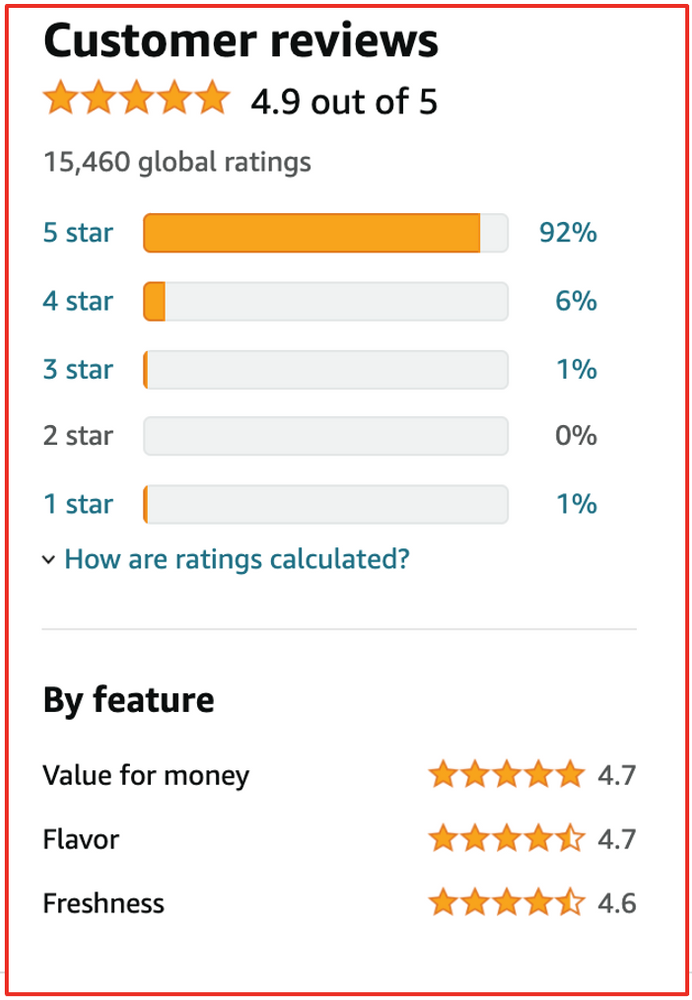The following analysis is the third in a series of special reports from The Mars Agency providing a comprehensive overview of the key digital marketing opportunities available through five leading retailers in the CPG marketplace.

Quality vs. Quantity? Both count.
As we continue our Digital Commerce Roadmap series, we’re pleased to direct our focus to “Ratings & Reviews.”
We previously touched on the critical importance of driving traffic to your product detail pages, landing pages, or brand stores, and offered some recommendations for winning search. (If you haven’t already, we encourage you to check them out. )
We’ll now shift to a question that I get asked all the time: How do I drive more reviews on retailer.com sites?

The good news here is that many mass retailers allow brands to syndicate reviews to their sites. In this way, it’s not a Target.com-specific review per se, but a general review about the product. This helps brands drive immediate relevance and credibility, and it also rewards them for work that’s already been done.
“But what about Amazon?” you might ask. While Amazon doesn’t allow a brand to seed reviews, they’ve cracked down in a big way on gray and “black hat” tactics (like writing fake negative reviews), making major suspensions in 2021. Sure, the platform still has its issues, but this was a step in the right direction.
Our analysis below gets into the details of how you should think about Ratings & Reviews at our key retailers: Amazon, Instacart, Kroger, Target and Walmart. As you’ll read, it’s sometimes less about maximizing reviews and more about meeting certain thresholds at each retailer. We hope you enjoy it.
John Willkom, SVP-eCommerce
The Mars Agency
[email protected]
FAST FACTS:
- 91% of consumers read reviews online
- 84% trust reviews like they do personal recommendations
- Consumers are 2.4x more likely to trust content created by other shoppers.
RATINGS & REVIEWS ON:

KEY CONSIDERATIONS
Consider sourcing reviews for new products through Amazon Vine, a program that invites vetted buyers to become reviewers (“Vine Voices”) based on the insightfulness of their published reviews for Amazon purchases. Qualified selling partners provide free units of product to the group.
Amazon no longer allows brands to respond to ratings/reviews. However, mining your reviews is important, not only for future content iterations but for overall product development and go-to-market strategies. This is direct feedback from customers, so listen, learn, and apply the insight across future products, messaging, and marketing activations.
The number of reviews needed to rank highly in search results is relative to other Page 1 brands. Consistently sourcing new reviews is better than delivering an influx all at once.

RATINGS & REVIEWS ON:

KEY CONSIDERATIONS
Instacart doesn’t use reviews. Instead, it relies on in-store placements to justify product quality and demand.
But, you can use reviews from other platforms to inform your keyword strategy at Instacart as well as your potential innovation pipeline.
For more insight, read “Cheers to Instacart.”
RATINGS & REVIEWS WITH:

KEY CONSIDERATIONS
Unlike other retailers, Kroger does not allow shoppers to post product reviews freely.
To generate genuine reviews, brands should enable sampling campaigns or review syndicators. They also can solicit feedback on their own website and import the reviews to Kroger sites.
Products on Kroger sites should have 100-plus reviews and an average star rating of 4.6 or higher.
For more insight, read “Evaluating the New Kroger PMP”
RATINGS & REVIEWS ON:


KEY CONSIDERATIONS
Target allows for review syndication. These tools can be leveraged to drive credibility and help new items gain relevance.
According to Profitero, the best performing products on Target.com have between 128 and 529 reviews.
Leverage sampling campaigns and review syndicators to generate genuine reviews and aim for a minimum star rating of 4.0. Unlike other retailers, Target’s algorithm doesn’t place much weight on star ratings.
RATINGS & REVIEWS ON:

KEY CONSIDERATIONS
Walmart also allows for review syndication, providing another opportunity for brands to leverage these tools to drive credibility and help new items gain relevance.
According to Profitero, the best performing products on Walmart.com have an average of 746 reviews. PDPs with fewer than 100 reviews are considered incomplete.
Here, too, sampling campaigns and review syndicators can be sourced to generate genuine reviews.
A minimum star rating of 4.0 should be targeted — but purchase probability peaks when the rating is between 4.2 and 4.5. Note: a perfect 5-star rating is often perceived by shoppers as too good to be true.
For more insight, read “Evaluating the New Walmart DSP”
Special thanks to Profitero for the foundational insights behind this report.

About the Author
John Willkom is the Head of Ecommerce at The Mars Agency, where he helps brands win in the ever-changing world of connected commerce. John has a passion for brand building and discovering “what’s next,” is an avid sports fan, and accomplished author, having penned the Amazon best-selling book, Walk-On Warrior, in 2018. John and his wife, Allison, have two daughters and call Minneapolis home. He can be reached at [email protected].